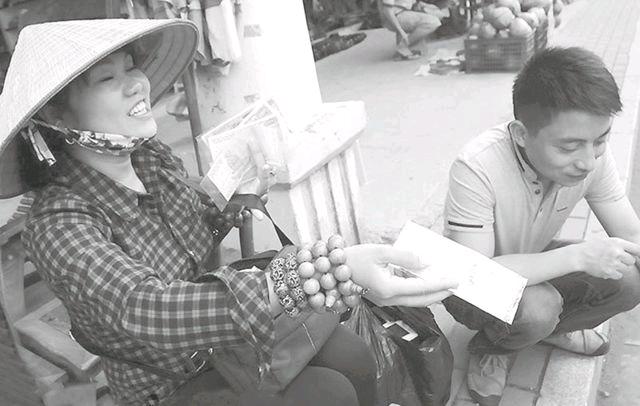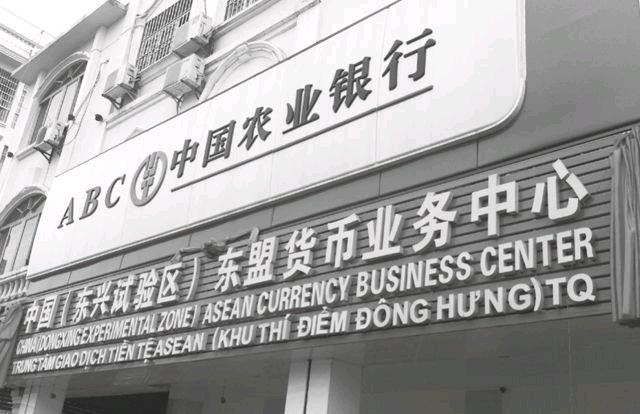China-Vietnam Cross-border Use of Yuan: A Story Begins with Bank Stalls
2015-04-23

“Bank stalls”, which refer to Vietnams pri- vate bank-like stalls that specialize in the service of the direct exchange between the Chinese yuan and the Vietnamese dong at the border of China and Vietnam, are gradually going out of sight, thanks to efforts made by the Chinese government to internationalize the yuan in recent years.
It is said that it takes only tens of thousands of yuan to obtain the approval of Vietnams government for the establishment of such a bank stall.
Before 2009 when China kick-started the plan to promote the use of the yuan in global trade, due to a lack of an international financial cooperation mechanism, high fees for bank settlement services and complicated procedures, merchants near Chinas border with Vietnam tended to make deals in cash and conduct currency conversions via bank stalls instead of regular banks, which caused the rampancy of bank stalls in the region.
At that time, due to the absence of official exchange rates between the yuan and the dong, the conversion between the two currencies had to be conducted via the US dollar and it was all up to those bank stalls to decide the market price, contributing to large differences in the rates from one bank stall to another.
Nowadays, under the governments reform policies, more and more regular banks have provided border trade settlement business for enterprises and individuals engaged in the crossborder trade, with faster, safer and more convenient legal settlement approaches.
As a result, the bank stalls, which have thrived in the grey zone for decades, find them gradually squeezed out of the market.
Say Goodbye to Bank Stalls
“The bank stall is a term that is not found in any financial textbooks, and it is a special result of the most common cash transactions among merchants during the early period of trade development at the border of China and Vietnam,” says Tang Zuoqin, a merchant who has run a shop in the largest agricultural product import and export market in Puzhai, a ChinaVietnam cross-border trade port in Guangxi Zhuang Autonomous Regions Pingxiang City, for nearly a decade.
“To be specific, the bank stall is a Vietnams private stall that provides the direct exchange of the yuan and the dong,”adds Tang.
In bank stalls, the whole currency conversion procedure is quite simple and rough, which is nearly primitive.
At the time when the border trade has not been stan- dardized yet, such bank stalls not only conducted the direct exchange of the yuan and the dong, but also provided other services, inclusive of the agency payment, temporary financing and transaction guarantees, according to a director of the International Department at the Pingxiang Branch of the Agricultural Bank of China (ABC).
“Owing to the lack of supervision, in the process of doing business with the bank stalls, especially entrusting them to make payments as agencies, the merchants have a much higher probability of being cheated by illegal currency traders, although the procedures are simpler and settlement fees are lower. Once you fall into traps, your funds are bound to be wiped out,” says Mr. Xi, one of more than 3,000 cross-border merchants in Dongxing, Guangxis the largest trade port city near the border with Vietnam.
However, the situation has changed a great deal with Chinas efforts to expand the use of the yuan in trade with Vietnam paying off.
Nowadays, the trade ports scattered along the 4000-kmlong border of China and Vietnam, no matter the scale is large or small, see the cash flows steering away from bank stalls into regular banks, a sign that merchants at the border will bid farewell to bank stalls in the foreseeable future.
Internationalization of the Yuan
In July 2009, the State Council of China approved the Cross-Border Trade Yuan Settlement Pilot Project to help establish pools of offshore yuan liquidity, marking the start of the internationalization of the yuan.
In the following years, the country launched a string of programs to accelerate the globalization of the yuan, including expanding the investment quota under its Renminbi Qualified Foreign Institutional Investors (RQFII) that allows foreign investors access to stocks traded on Chinas mainland, connecting the Shanghai Stock Exchange to its counterpart in Hong Kong and liberalizing the yuans capital account in the Free Trade Zone (FTZ) in Shanghai.
With Chinas rapidly growing economy, the cross-border yuan business has boomed over the past five years, showing its strong vitality.
Since China kicked off the program to expand its official currencys use in global trade in 2009, the number of countries and regions settled trades with China in yuan has added up to 174.
With the countrys economy gaining momentum and crossborder trade expanding in recent years, the yuan has become the 8th most-traded currency in the world by 2013 and jumped to the 7th place as of May 2014.
According to data, the total cross-border yuan settlement in the first three quarters of 2014 amounted to 4.8 trillion yuan, compared with less than 3.6 billion yuan five years ago.
The yuan has become Chinas second most-used cross-border payment currency, with almost 25% of the countrys total transactions settled in it, according to a recent statement made by Hu Xiaolian said, deputy governor of the Peoples Bank of China (PBOC).
“Reform and opening-up helps boost the yuan settlement business, and the globalization of the yuan has contributed a lot to the international financial market,” says the deputy governor.
ASEAN Currency Business Center
In 2013, China was Vietnams largest trade partner with a total turnover of US$50.21 billion, a increase of 22% compared with a year earlier, according to statistics from the Vietnam Customs.
During the period, Vietnams imports from China rose 28.4% from a year earlier to US$37 billion, accounting for 28% of its total import value, while its exports to China grew to US$13 billion, a year-on-year increase of 7%, making up for 10% of its total export value, the statistics showed.
In 2015, the two-way trade turnover between the two countries is expected to hit US$60 billion, according to the customs department.
In view of the ever-growing trade relationship with Vietnam and the rampancy of illegal private currency trading led by the bank stalls, China is stepping up efforts to promote the cross-border yuan business at the border region.
In April 2014, China established the ASEAN (Association of Southeast Asian Nations) Currency Business Center in the China-Vietnam border city Dongxing.
The currency trading center, the first of its kind in the country, was set up by Dongxing-based branches of five banks whose businesses include the cross-border trade settlement, namely the Industrial and Commercial Bank of China, the Agricultural Bank of China, the Bank of China, the China Construction Bank, and the Beibu Gulf Bank.
The establishment of the currency trading center is helpful to end rampant illegal private currency trading, as it allows the direct exchange of the yuan and the dong, which is a big blow to the business of bank stalls.
The exchange rate between the yuan and the dong is calculated based on the two currencies exchange rates against the US dollar and is published by the abovementioned five banks in turns.
To be specific, the exchange rate between the dong and the dollar is offered by Vietnams settlement banks, while the exchange rate between the yuan and the dollar is provided by Chinas banks.
Currently, trades in Dongxing are mainly settled in yuan and dollar, with 98% of the citys total trades settled in yuan. The yuan has been considered as a hard currency in the China-Vietnam cross-border trade since it is more stable than the dong.
Besides, a more streamlined procedure for the cross-border trade settlements in Dongxing commercial banks and the establishment of the ASEAN Currency Business Center boost the development of the yuan settlement business in the city.
As of June 30th, 2014, the crossborder yuan settlement in the Dongxing Experimental Zone has exceeded 12 billion yuan, up 153% from the same period a year earlier, realizing the rapid expansion of regional trade and investment.
杂志排行
中国经贸聚焦·英文版的其它文章
- Towards a Comprehensive Understanding of New Normal
- S&P: Real estate downturn may pose biggest risk to Chinese banking sector
- China to roll out policies to support robotic and intelligent equipment manufacturing in H1 2015
- The Threat of Deflation
- CPI Trend from Nov.2013 to Nov.2014
- Latest Public Official Changes in China
